Related Research Articles

Richard Meier is an American abstract artist and architect, whose geometric designs make prominent use of the color white. A winner of the Pritzker Architecture Prize in 1984, Meier has designed several iconic buildings including the Barcelona Museum of Contemporary Art, the Getty Center in Los Angeles, the High Museum of Art in Atlanta, and San Jose City Hall. In 2018, some of Meier's employees accused him of sexual assault, which led to him resigning from his firm in 2021.
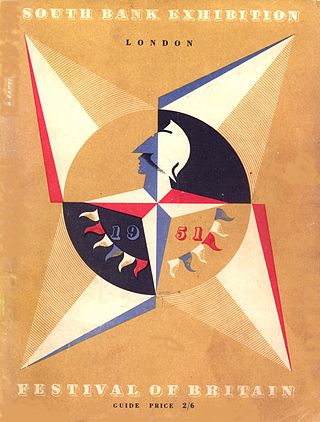
The Festival of Britain was a national exhibition and fair that reached millions of visitors throughout the United Kingdom in the summer of 1951. Historian Kenneth O. Morgan says the Festival was a "triumphant success" during which people:
flocked to the South Bank site, to wander around the Dome of Discovery, gaze at the Skylon, and generally enjoy a festival of national celebration. Up and down the land, lesser festivals enlisted much civic and voluntary enthusiasm. A people curbed by years of total war and half-crushed by austerity and gloom, showed that it had not lost the capacity for enjoying itself....Above all, the Festival made a spectacular setting as a showpiece for the inventiveness and genius of British scientists and technologists.

The International Style or internationalism is a major architectural style that was developed in the 1920s and 1930s and was closely related to modernism and modernist architecture. It was first defined by Museum of Modern Art curators Henry-Russell Hitchcock and Philip Johnson in 1932, based on works of architecture from the 1920s. The terms rationalist architecture and modern movement are often used interchangeably with International Style, although the former is mostly used in the English-speaking world to specifically refer to the Italian rationalism, or even the International Style that developed in Europe as a whole.
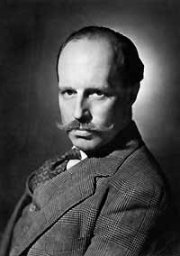
Sir Basil Urwin Spence, was a Scottish architect, most notably associated with Coventry Cathedral in England and the Beehive in New Zealand, but also responsible for numerous other buildings in the Modernist/Brutalist style.
Sir Michael John Hopkins was an English architect.
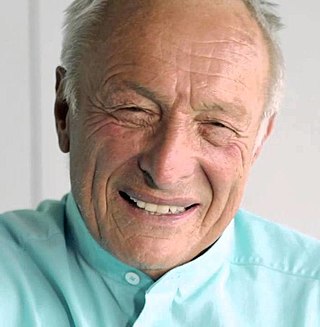
Richard George Rogers, Baron Rogers of Riverside, was a British-Italian architect noted for his modernist and constructivist designs in high-tech architecture. He was a senior partner at Rogers Stirk Harbour + Partners, previously known as the Richard Rogers Partnership, until June 2020.

Dame Zaha Mohammad Hadid was an Iraqi-British architect, artist and designer, recognized as a major figure in architecture of the late-20th and early-21st centuries. Born in Baghdad, Iraq, Hadid studied mathematics as an undergraduate and then enrolled at the Architectural Association School of Architecture in 1972. In search of an alternative system to traditional architectural drawing, and influenced by Suprematism and the Russian avant-garde, Hadid adopted painting as a design tool and abstraction as an investigative principle to "reinvestigate the aborted and untested experiments of Modernism [...] to unveil new fields of building."

Charles Mark Correa was an Indian architect and urban planner. Credited with the creation of modern architecture in post-Independent India, he was celebrated for his sensitivity to the needs of the urban poor and for his use of traditional methods and materials.
The year 1976 in architecture involved some significant architectural events and new buildings.
Arup is a British multinational professional services firm headquartered in London that provides design, engineering, architecture, planning, and advisory services across every aspect of the built environment. It employs about 17,000 people in over 90 offices across 35 countries, and has participated in projects in over 160 countries.
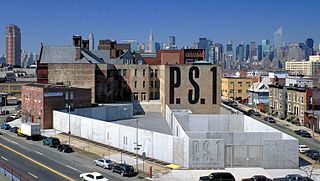
MoMA PS1 is a contemporary art institution located in Court Square in the Long Island City neighborhood in the borough of Queens, New York City, United States. In addition to its exhibitions, the institution organizes the Sunday Sessions performance series, the Warm Up summer music series, and the Young Architects Program with the Museum of Modern Art. MoMA PS1 has been affiliated with the Museum of Modern Art since January 2000 and, as of 2013, attracts about 200,000 visitors a year.
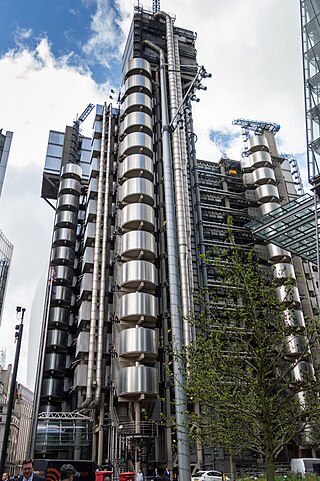
High-tech architecture, also known as structural expressionism, is a type of late modernist architecture that emerged in the 1970s, incorporating elements of high tech industry and technology into building design. High-tech architecture grew from the modernist style, utilizing new advances in technology and building materials. It emphasizes transparency in design and construction, seeking to communicate the underlying structure and function of a building throughout its interior and exterior. High-tech architecture makes extensive use of aluminium, steel, glass, and to a lesser extent concrete, as these materials were becoming more advanced and available in a wider variety of forms at the time the style was developing – generally, advancements in a trend towards lightness of weight.
Hopkins Architects is a prominent British architectural firm established by architects Sir Michael and Patricia, Lady Hopkins.

The Forum is a public building in Norwich, United Kingdom. Opened in 2001, the building was designed by the British architectural firm Sir Michael Hopkins and Partners and exists on the site of and replaces the Norwich Central Library, which burnt down in 1994. Following a design which was initially rejected, the final version of the building contains the Norfolk and Norwich Millennium Library to the west end of the building with office and commercial spaces, and studios for the BBC around a main atrium. The building is fronted by a glass façade with a surrounding brick wall and inner steel frame supporting a glass and zinc panel roof. The project cost £66 million, of which £31 million was from the Millennium Commission. The library has been named one of the most popular in the country, while The Forum is a venue for public events and festivals and the outside plain hosts live performances. Despite winning several awards, the building has been criticised for its use of materials and has been likened to a shopping mall and airport terminal.
The year 2012 in architecture involved some significant architectural events and new buildings.

Iain Mackintosh is a British practitioner of theatre combining four interwoven careers as theatre producer, theatre space designer, curator of theatre painting and architecture exhibitions, and author and lecturer on both modern and eighteenth century theatre. He has campaigned for the retention and restoration of historic theatres as working homes for live performance.
Patricia Ann Hopkins, Lady Hopkins is an English architect and joint winner, along with her husband Sir Michael Hopkins, of the 1994 Royal Gold Medal for Architecture.
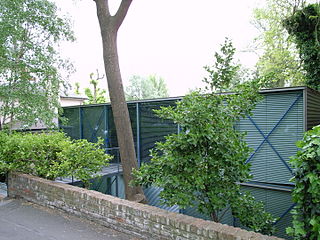
The Hopkins House at 49a Downshire Hill is the common name given to the high-tech home and workspace in Hampstead, London (1976), designed by architects Michael and Patty Hopkins. It has been described as a "genuine icon of the High Tech movement". The house won a RIBA Award for Architecture in 1977 and a Civic Trust Award in 1979.
British high-tech architecture is a form of high-tech architecture, also known as structural expressionism, a type of late modern architectural style that emerged in the 1970s, incorporating elements of high tech industry and technology into building design. High-tech architecture grew from the modernist style, using new advances in technology and building materials.

The year 2023 in architecture involves some significant architectural events and new buildings.
References
- 1 2 Merrick, Jay (19 November 2013). "The Brits Who Built the Modern World and 49b - the house built by High Tech designers Michael and Patty Hopkins". The Independent. Retrieved 8 February 2014.
- ↑ Considine, Pippa (4 February 2014). "BBC Four to run season on architecture". Televisual. Retrieved 8 February 2014.
- ↑ "BBC Four celebrates architecture with Nation Builders season". BBC. 3 February 2014. Retrieved 8 February 2014.
- ↑ "BBC highlights the Brits who Build the Modern World". Construction Manager. 6 February 2014. Retrieved 8 February 2014.
- ↑ "OU on the BBC: The Brits Who Built The Modern World". Open University. 3 February 2014. Retrieved 8 February 2014.
- ↑ "The Brits Who Built The Modern World". RIBA. Retrieved 8 February 2014.
- ↑ Richard Waite, Laura Mark (5 March 2014). "BBC slammed for 'bias' after Patty Hopkins is sidelined in TV show". Architects' Journal . Retrieved 23 October 2015.
Deborah Saunt co-founder of DSDHA, said: 'The point is that the BBC are publicising the work of these great British architects without including a very important sixth member (being a full partner in Hopkins Architects from the beginning) - a member who was present at the time when the group photo was taken! To knowingly choose to use a metaphorically or literally edited photo without Patty in it, is an outrage.'